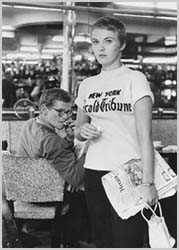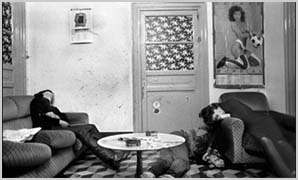|
From PHOTOWORKSHOP.COM Education and Inspiration
There are pictures that have a lasting effect on me. Jean Seberg on the streets of Paris selling newspapers, for instance. How come I can recall it so easily? Is it because it represents something of importance to me? Is it because I had first laid eyes on it when in my early youth and was full of longings? Is it because I've looked at it more often than at other pics? Or is it simply because I find Jean Seberg so adorable? Needless to say, I do not have an answer, I have only guesses, and these depend on a variety of factors beyond my control - my mood, for instance, or my willingness, or...These guesses also have the tendency to change over time - what I deemed relevant as a teen I often considered not even worth my attention in later years.
Left: "The bodies of two drowned Roma children lie covered by towels on an Italian beach while holiday-makers carry on unfazed enjoying the sun" (Daily Mail, 20 July 2008) There are other pictures, though; pictures that I do not so easily recall despite the fact that I consider them important, necessary and relevant. I need to make an effort to bring them into my consiousness. The picture above, for instance, that shows the bodies of two drowned Roma children covered by towels on an Italian beach while holiday-makers carry on unfazed enjoying the sun, as the Daily Mail (20 July 2008) wrote. Or the photograph below by Letizia Battaglia who became famous for documenting the crimes of the Mafia and who says about it: Choosing between good and evil is easier and clearer here than elsewhere. The photo, from 1982, documents the triple murder of a prostitute and her clients. Henri Matisse, who is known primarily as a painter, once said that every painter has only (if at all) two or three ideas which he has constantly to turn to so that they do not vanish. It does indeed seem that reduction is key - we not only prevent ourselves from getting lost, we also give direction and purpose to our life.
Right: Palermo, 1982 (Letizia Battaglia) The problem is not that people remember through photographs but that they remember only photographs. This remembering through photographs eclipses other forms of understanding - and remembering. The concentration camps - that is, the photographs taken when the camps were liberated, in 1945 - are most of what people associate with Nazism and the miseries of the Second World War, Susan Sontag wrote in Looking at War (The New Yorker, 9 December 2002). If we do not wish to become victims of such image remembering, we need to visually educate ourselves. And that essentially means to be inquisitive, to always ask questions when looking at photographs. Most useful are the five W's: who, what, when, where and why. Equally useful is to ask how the picture came about, how the photographer did it. Memory is not static, it is constantly evolving, it is made up. And that implies that we can influence it by becoming visually literate. I'm glad I was made aware of Letizia Battaglia's pictures. And I'm willing to make an effort to remember them, and that includes the stories that accompany them. 2012 © Hans Durrer / Soundscapes © Copyright by PHOTOWORKSHOP.COM |


